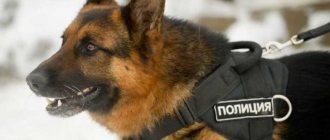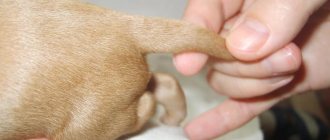It is unlikely that anyone will be able to accurately answer how many dog monuments, sculptures and complexes there are in the world dedicated to man’s best friend, and each has its own story.
Monuments to a dog - man's best friend and faithful assistant
One of the first monuments to a dog is considered to be the monument in Corinth, erected in the 4th century BC. According to legend, a dog named Soëtre woke up the city garrison when the enemy decided to make a surprise attack under cover of darkness. The enemy was defeated, and the dog was awarded a silver collar with the inscription: “Defender and Savior of Corinth.”
Monuments to military and service dogs
There are a lot of monuments to military and service dogs in the world, because in these areas of human life they are given a special place and many professions. Some are no longer so relevant, for example, mine demolitions, postmen, but in others, where scent, intelligence and loyalty are required, a worthy replacement for the dog will not be found for a long time.
Monument to Antey
On the pedestal of the monument in Novosibirsk it is written: “To Antey, a faithful friend in the struggle for the safety of socialist property in 1968-1980. With its help, more than 100 criminals were detained and 62 crimes were solved.”
The first monument to a service dog in the USSR is dedicated to an East European shepherd named Antey. He served for 13 years in the paramilitary railway guard. He died at an old age in the nursery where he was born, on Inskaya. The monument was erected in 1983 by order of the head of the West Siberian Railway I. Trubnikov.
Military Dobermans
The "Always Faithful" memorial commemorates the feat of the US Marine Corps' military dogs. Opened in 1994, on the 50th anniversary of the Battle of Guam.
In 1941, Guam was captured by Japanese troops and held for 2.5 years. In July 1944, US Marines landed on the island to retake their territory. Together with them there were 60 fighting dogs. They served as sentries, messengers, and scouts, exploring cave systems, detecting mines and traps, and guarding the sleeping.
The most famous was a Doberman named Kurt. He saved hundreds of soldiers when he warned them of Japanese forces ahead. The dog was seriously wounded by mortar fire and was the first of 25 dogs to die, with another 20 injured.
Military instructor
The sculpture in St. Petersburg “Military Instructor with a Dog” is a tribute to the memory of animals who worked on the battlefields during the Second World War.
The location for the monument was not chosen by chance. Since 1924, the Red Army service dog breeding school was located here. In the post-war years, the Krasnaya Zvezda kennel, where the Moscow Watchdog and the Black Russian Terrier were bred.
Other monuments to military and service dogs
To the “demolition dogs” who defended Stalingrad during the Great Patriotic War, Volgograd (left). “For Frontline Dogs”, Moscow.
“To the medical heroes and ambulance dogs”, Esentuki (left). “Border guard with a dog”, Blagoveshchensk. To military trainers and dogs", St. Petersburg (right).
Animals at War Memorial, London, UK
Photo: wikimedia.org
The British are known to be famous for their love of animals. In 2004, an unusual memorial was unveiled on the corner of Hyde Park in London. It is dedicated to all the animals that served in the British and Allied forces and died in military conflicts. Homing pigeons, a dog, camels, horses, an elephant, a mule, an ox, a cow and a cat - all these animals are depicted on the monument.
The memorial was erected with donations from private individuals, which were accepted by a specially created fund. In total, they managed to raise 1.4 million pounds sterling (147.9 million rubles). The monument's creators were inspired by Jilly Cooper's book Animals at War, published in 1983.
One of the inscriptions on the monument reads: “They had no choice.” On the wall you can also see a bas-relief depicting the Mary Deakin Medal, Britain's highest military award for animals. This memorial badge was first awarded in 1942, and since then more than 60 animals have been awarded it, including dogs, pigeons, horses and one cat.
2
Immortalized stories of canine fidelity
Scottish Terrier Bobby
Bobby the Scottish Terrier is an example of exceptional loyalty. Monument erected in Edinburgh, Scotland
Bobby was the dog of John Gray, a night guard for the Edinburgh police. For 2 years the friends were inseparable, but in 1858 John died of tuberculosis and was buried in Edinburgh in Greyfriars Cemetery. Bobby outlived his owner by 14 years. He spent the remaining years at his grave, only occasionally going to a nearby restaurant to eat or to nearby houses to survive the severe frosts.
In 1868, Bobby was supposed to be euthanized like a dog without an owner, but the Lord Provost of Edinburgh, Sir William Chambers, took him into his care, paying taxes and fees for a care license.
Bobby died in 1872 and, since he could not be buried within the cemetery, rests in front of the gate, not far from the grave of John Gray. A year after the dog's death, Baroness Angela Bardot Kutz ordered the erection of a fountain statue in his honor.
Monument to Devotion
The monument was erected on July 1, 2003. It became the first non-political monument in Tolyatti, Russia
In the summer of 1995, a German shepherd dog appeared on the side of the Southern Highway in Tolyatti. He wandered around the same place. Townspeople from neighboring houses fed and tried to shelter the lost one, but every now and then he found himself by the road, sadly watching the cars and rushing towards the cherry "nines". 7 years later the dog died. Where it came from and who its owners were is unknown.
Urban legend says that the owners of the shepherd were newlyweds who were returning from their honeymoon when they had an accident. The young wife died before the doctors arrived, and a few hours later the man died in intensive care. The dog waited for 7 years for their return in the place where it was last seen.
Dog Jock
Monument to the dog Jock, who knows firsthand about loss, Krakow, Poland
The owner of the dog Jock died suddenly at the Grunwald roundabout from a heart attack. The faithful dog wandered around the area for a whole year, waiting for his return, until a woman named Maria Muller took him in. 7 years later she died, reminding the dog of the bitterness of rubbing. Local residents say that after Maria's death, Jock ran away from home and soon died under the wheels of a train.
The monument was erected on May 26, 2001, it depicts a dog, which is located inside the palms and extends its left paw to a person as a sign of trust and gratitude.
Hachiko
This dog has become a symbol of fidelity not only in Japan, but throughout the world. On April 21, 1934, a monument was erected to Hachiko at Shibuya Station. The dog was personally present at its opening. During the Second World War, the monument was destroyed, but restored in August 1948.
Hachiko was born on November 10, 1923. As a puppy, he was given to Professor Hidesaburo Ueno, who worked at the University of Tokyo. The Akita Inu dog was his 8th dog, so he received the nickname Hatiku from Japanese. hachu – “8” and ko – “devotee”. Every morning he accompanied the owner to the train, and in the evening he met him at the station.
On May 21, 1925, a professor at the university suffered a stroke. The doctors could not help him and he never returned home. That day, Hachiko did not wait for his owner. Without losing hope, he began to come to the station every day and patiently waited for the professor until late in the evening, and then returned home and spent the night on the porch. Hachiko came to the station for 9 years. Died March 8, 1935. His remains are kept in stuffed form at the National Science Museum in Tokyo.
Old Shep
The monument was erected by the townspeople after Shep died under the wheels of a train. The inscription on the plaque: “Shep “Always Faithful”.”
In the small town of Fort Benton, Montana, USA, you can see a monument to a dog who sadly looks at the river. This is a sheepdog named old Shep. For 5.5 years, he came to the station every day in anticipation of his owner, whose body was sent to relatives by train after his sudden death.
Greyfriars Bobby Monument, Edinburgh, UK
Photo: tammytourguide.wordpress.com
This Skye terrier for fourteen years - until his death in 1872 - guarded the grave of his deceased owner, a night guard for the Edinburgh police.
The monument to Greyfriars Bobby was erected during the dog’s lifetime, although he never lived to see the opening. The life-size statue stands in front of Greyfriars Bobby bar.
The first monument to a dog
It is believed that the first monument to a dog was erected in the 4th century BC in the ancient Greek city of Corinth. According to legend, a dog named Soetre woke up the garrison of the city when the enemy crept up on it. The enemy was repulsed, and Soetre was awarded a monument and a silver collar with the inscription “Defender and Savior of Corinth.”
Later, on Bobby’s grave, located in front of the gates of the cemetery where his owner rests, a red granite stone appeared with the inscription “Let his loyalty and devotion be a lesson to us all.” The initiator of the installation of the stone was the Scottish Dog Aid Society.
8
Rescue dogs and human assistants
Fires, floods, rubble and avalanches - in all natural and man-made disasters, the dog stands guard over the preservation of human life. Rescue dogs are able to find and indicate the location of a victim, dig a victim out from under the snow, pull a drowning person out of the water, and follow the scent of a lost person. It’s impossible to count how many lives they saved and for how many people they became angels in the flesh.
St. Bernard Barry
A monument to Barry is erected in a dog cemetery near Paris. The sign on it reads: “He saved 40 people, but was killed trying to save the 41st.”
St. Bernards have a long history of saving people from snowfall. Barry became famous for this. He lived in the monastery of St. Bernard on a pass in the Alps, where the monks provided shelter to travelers and were the first to use dogs to rescue people in the mountains. During his life, Barry saved about 40 people. The most famous case was the rescue of a little boy. The dog found him unconscious in an ice cave after an avalanche. When the child came to his senses and was able to climb onto the dog’s back, Barry took him to the monastery. The boy survived and was returned to his parents. It is this moment that is found on old postage stamps, postcards and later immortalized in the form of a monument.
Legend has it that Barry died at the hands of a frightened Swiss soldier who mistook the dog for a wolf and fatally wounded him with a bayonet. But it is not true. After serving for 12 years, Barry retired and lived with a monk in Bern, where he died at the age of 14.
Fire dog Bobka
Monument to the fire dog Bobka, Kostroma.
The legendary dog Bobka lived in the center of Kostroma at the end of the 19th century in a fire tower and was considered an integral member of the city fire brigade. He accompanied the fire chiefs on field trips, helped rescue people from the fire and carry things out. Leonid Kolgushkin wrote a story about Bobka’s exploits, and in 2009 a monument was erected to the dog.
Talented rescuer Manx
Manx (1994–2006) is one of the most famous and talented rescue dogs in Miskolc, Hungary.
Manx's special talent was locating earthquake survivors who lay trapped deep beneath the rubble. He could locate people buried under rubble and indicate to rescuers whether a person was alive or dead. when the dog sensed something alive under the rubble, it wagged its tail and barked; when it sensed something dead, it lay down.
Affectionate Brittany
Brittany was a rescue dog for 9 years and "retired" as a therapy dog at an elementary school. The monument was erected in West Orange, New Jersey, USA.
The first task of the golden retriever Brittany was to search for victims in the ruins of the World Trade Center on September 11, 2001. Then she traveled with search teams to disaster sites more than once. During her service she saved more than 300 people. The dog comes from Cyprus, where it was also honored with a small monument.
Towser Cat Monument, Crieff, UK
Photo: flickr.com/Karen Bryan
Another memorial in Scotland perpetuates the memory of the cat Towser, who became famous for the record number of mice caught - almost 29 thousand in 24 years of life. Her “labor feat” did not go unnoticed and was included in the Guinness Book of Records.
The cat lived at the oldest distillery, Glenturret, where the most popular whiskey in Scotland, The Famous Grouse, is produced. Since whiskey is made from selected grains, there were always a lot of mice at the enterprise, with which the Towser cat successfully fought.
The monument is located right in front of the distillery, whose workers are sure that the cat owes its dexterity and longevity to its daily serving of milk with the addition of a drop of whiskey, as well as to the alcohol fumes that it had to inhale every day.
For contribution to science
In many cities around the world, monuments have been erected to experimental animals that have contributed to science. For example, in the courtyard of St. Petersburg University there is a monument to an experimental cat, and near the building of the Pasteur Institute in Paris there is a monument to a frog.
Employees of the Novosibirsk Institute of Cytology and Genetics of the Russian Academy of Sciences immortalized the merits of experimental rodents by installing a sculpture of a mouse “knitting” a DNA helix with knitting needles on the academic campus. Residents of Sukhumi, in turn, paid tribute to the monkeys who participated in experiments in the study of human diseases.
Back in the mid-30s, a monument to an experimental dog appeared on Aptekarsky Island in St. Petersburg. The idea of the monument belongs to Academician Pavlov - the same one who became famous for his experiments on four-legged animals.
11
Balto
Balto was a sled dog in the small town of Nome, Alaska. For the first few years of his life, he carried food for the city and was considered rather slow and unsuited to hard work.
In early 1925, diphtheria broke out in Nome, Alaska, and patients needed anti-diphtheria serum, which had to be shipped from a city a thousand miles away. Planes were unable to take off due to a severe snowstorm, so the serum was delivered by train as close as they could. The remaining part of the journey, 1805 km, had to be covered by dog sleds. Leonard Seppal walked 425 km with his Siberian husky Togo, who was the leader in the team. The last 12 km to Nome were walked by Gunnar Kaasenad and Balto. They got all the glory. In total, 150 dogs were involved in transporting medicines.
Literary Bim on Voronezh land
Voronezh fellow countrymen of the writer Gabriel Nikolaevich Troepolsky, as a sign of gratitude for his talented story “White Bim the Black Ear,” erected a monument to the literary hero of the story - Bim, a Scottish setter. The monument is located near the Puppet Theater in the city of Voronezh. Bim, who unwittingly found himself on the street due to his owner’s illness and tried to find him on his own, encounters both human compassion and human cruelty on his way.
To the dogs of the Arctic station Syova
In 1958, a group of Japanese researchers working at the Showa meteorological station was forced to make an emergency evacuation, leaving behind 13 Karafuto (Sakhalin Huskies) sled dogs. They should have returned for them, but this did not happen.
A year later, another expedition arrived at the station, and what a surprise the scientists were when they were met by two living huskies, Taro and Jiro.
Monument to the cat Semyon, Murmansk
Photo: TASS/Lev Fedoseev
If Lomonosov's journey on foot to Moscow took three weeks, then the cat Semyon managed to return home from the capital to Murmansk only six years later. Legend has it that the cat got lost in Moscow in the late 80s and somehow found its way back.
The animal traveled two thousand kilometers and became a symbol of devotion and perseverance. The monument to the cat Semyon is located at the entrance to the amusement park near Lake Semenovskoye.
Plot: City trends: everything that worries the capital
In honor of a beloved friend
Irish Wolfhound Gelert
This is one of the oldest dog monuments in the world. It was erected in the 13th century in North Wales to a faithful dog that died as a result of a tragic mistake.
The sad legend of Gelert is one of the most beloved stories in Wales.
The Irish Wolfhound was the dog of Prince Llywelyn the Great and always accompanied him on the hunt, but one day he did not respond to the calling horn. Returning home, the prince found his son's cradle overturned and Gelert with his mouth stained with blood. Believing that the dog had attacked the child, Llywelyn drew his sword and plunged it into Gelert. Immediately after the dog's dying squeal, the prince heard the cries of his unharmed son under the cradle and saw a dead wolf killed by the dog. From that day on, Llywelyn never smiled again.
The 800th anniversary of the legend was celebrated with an update. The old stone sculpture was replaced with a new bronze one.
Sad stories of “Hachiko” in Tolyatti and Chelyabinsk
The stories of dogs are similar - a German shepherd from Tolyatti and a mongrel from Chelyabinsk - both were left without an owner after a car accident, both were constantly on duty by the road, both were waiting for the owner to return until the last day of their lives...
Sad stories of friendship were immortalized in memorable bronze figurines of dogs. If in the city on the banks of the Volga the sculpture was called “Monument of Devotion,” then in Chelyabinsk it was called “Monument to Hachiko.”
The king's mongrel dog
A monument to the mongrel dog of the King of Siam was erected in front of the palace complex in Nakhon Pathom province, Thailand, 56 km west of Bangkok.
According to the description, Yali was a mongrel dog who was born and served as a rat catcher in one of the prisons of Siam. The king was visiting places of detention with inspection when he saw Yale at work. He was so amazed by her abilities that he decided to take her to serve in the palace.
The surviving records say that Yale was an intelligent and loyal dog, selflessly devoted to the king. She was shot dead by unknown assailants in 1922. The king loved his friend so much that he organized a magnificent funeral for him, wrote an epitaph and ordered a huge monument on a pedestal.
The president's favorite breed
Around the 9-meter pedestal there is a built-in screen on which various videos with the participation of Alabai are shown.
President of Turkmenistan Gurbanguly Berdimuhamedov opened a gilded monument to Alabai with a total height of 15 meters in Ashgabat, created on his initiative.
The monument was erected to “show respect for the incredible courage and big heart of these wonderful animals, emphasizing their role in the historical destiny of the nation and the place they occupy in the life of the people,” Berdymukhamedov said.
Monument to the cat Elisha and the cat Vasilisa, St. Petersburg
Photo: kudago.com
On Malaya Sadovaya Street in St. Petersburg, two miniatures were installed in memory of the siege cats that were brought from the Yaroslavl region to save the city from rats. The cat Vasilisa was located on the eaves of the second floor of house No. 3, and the cat Elisha was opposite her, on the corner of house No. 8.
During the siege, not a single cat remained in Leningrad, which led to an invasion of rats that destroyed the last food supplies. To combat pests, cats were brought from Yaroslavl and they successfully completed the task.
Both monuments disappeared from their places. This happened to the cat Elisha in 2008, and to the cat Vasilisa in 2014. Fortunately, in both cases the sculptures were found and returned.
12
Dogs of Science
Pavlov's dogs
In the garden of the Institute of Experimental Medicine in St. Petersburg, a monument with a fountain was erected in honor of Pavlov's experimental animals.
The monument was created on the initiative of Academician Pavlov himself. He wanted to note the importance of the dog in his work on the physiology of nervous activity.
To the brown dog
In 1985, a new monument to the Brown Dog was erected in Battersea Park, London. It is intended to remind us that animal testing is still carried out in laboratories around the world, but it has no place in the civilized world.
The installation of the Brown Dog monument was preceded by one of the most high-profile cases to protect animal rights. We were talking about a ban on vivisection (live cutting), which was actively used in medicine. institutes and other scientific institutions. The case began in 1903 after a physiology lecture was performed on a brown dog without proper anesthesia.
Although the case was lost, it received widespread support. To perpetuate the memory of the dogs, including the 232 that died between 1902 and 1903, a monument fountain was erected in London. However, it was demolished after 4 years due to constant unrest around it.
In 1985, a new Brown Dog monument was erected in Battersea Park, London, to commemorate the ongoing problem. If in 1903 19,804 animals suffered and died in British laboratories, then in 1984 their number had already increased to 3,497,355 individuals. Not all were dogs, but most were subjected to terrible experiments and died in agony.
Other dog monuments were preceded by an equally tragic history.
Near the Medical University of Grodno you can see a monument to dogs with a thank you inscription: “For their invaluable contribution to the development of medical science” (left). A bronze statue of an adult dog and a puppy in Ufa commemorates dogs that were used for dental research (right).
Dogs for astronauts
It is difficult to overestimate the contribution of dogs to the development of astronautics. Little Laika became the first living creature to visit low-Earth orbit on the Soviet spacecraft Sputnik-2, and Belka and Strelka proved to the whole world that it is possible to return from space.
Ten more Russian dogs were sent into space before a man could make his first flight.
There are monuments to the first cosmonaut dogs not only in Russia, but also in other countries.
The sculptural composition “Belka and Strelka” was opened on June 26, 2017 in Tomilinsky Fairy Tale Park. According to urban legend, the world-famous dogs came from this working-class village (right). Monument to the squirrel and the arrow in the Dmitrovsky district of the Moscow region (in the middle). The monument to Laika, Belka and Strelka in the form of a marble rocket is installed in Crete in the Homo sapiens Museum (left).
The monument to Bbelka, Strelka and V. Tereshkova is located in Chelyabinsk, Russia. It opened in 2022 in the city park named after. Tereshkova and from the first day became the object of jokes of the townspeople. The first female astronaut appeared to be pregnant, and the monsters standing opposite her only vaguely resembled dogs. By the way, a few months after the flight, Strelka gave birth to healthy offspring of six puppies, one of them was presented to Caroline Kennedy by Nikolai Khrushchev.
The monument to Zvezdochka was erected near the former runway of the old Izhevsk airfield, where the dog was greeted from space (left). Monument to Laika on the territory of the Institute of Military Medicine on April 11, 2008 (middle). A monument to the dog-cosmonaut Chernushka was opened in Tatarstan, in the small town of Zainsk on March 9, 1961. Chernushka visited the planet's orbit and returned, and her capsule landed in the schoolyard in Zainsk (right).
Space travelers in Moscow and Izhevsk
At the beginning of the country's space journey, the first travelers were dogs - intelligent and hardy friends of man. The most famous of them are Laika, Belka, Strelka and Zvezdochka, all of them are dogs from the street. In addition to the cartoon characters Belka and Strelka, two commemorative sculptures were created for the astronaut dogs, who bore the nicknames Laika and Zvezdochka.
The monument to the traveler Laika, who went into orbit in 1957, is located in Moscow. She did not return from the flight, dying from overheating.
The monument to another traveler, Zvezdochka, is located in Izhevsk. In 1961, Zvezdochka completed the space travel of four-legged animals and landed safely in the Udmurt steppe, opening the way for human exploration.
Everyone's favorites
Bull Terrier Patsy Ann
Bull Terrier Patsy Ann was deaf from birth, but somehow sensed the approach of ships to the port of Juneau.
Patsy Ann was known to everyone in Juneau, Alaska. She knew before anyone else when the ships would arrive in the harbor and ran to the pier to meet them. This was a relief to the townspeople, who were awaiting supplies of provisions, medicine and clothing from the sea.
Patsy Ann lived in Juneau for 13 years (1929-1942). They buried her “at sea,” lowering her coffin into the water right in front of where she liked to sit. In 1992, a statue was installed so that the dog could continue to greet ships.
Brownie from Daytona Beach
75 people attended the funeral of the city's beloved dog, and the mayor himself delivered a eulogy.
Brownie was a stray dog who lived in downtown Daytona Beach, Florida from 1939 to 1954. He had no owner, but the whole city loved him. Brownie ate steaks, ice cream and lived in his own booth. He even had his own bank account where anyone could donate funds to help pay veterinary bills.
Brownie was buried in Riverfront Central Park under a granite slab with the epitaph "Brownie the City Dog."
Sympathy
The appearance of the “Sympathy” monument was preceded by a sensational story.
In the lobby of the Mendeleevskaya metro station in Moscow you can see a small monument to a stray dog. A bronze dog lies on a pedestal, scratching its ear with its hind paw. He reminds people that in this world everyone is responsible for living beings and especially those who are weaker.
There lived a dog, Boy, in the station passage. The calm and friendly mongrel was looked after by subway workers and was well known and loved by passengers. According to eyewitnesses, a young girl, seeing a peacefully sleeping dog, tried to set her dog on him, and then personally stabbed the dog 6 times in the chest, back and groin area. The boy could not be saved. The examination declared the girl insane.
In 2007, a monument was erected in the metro with the inscription on the slab: “Sympathy. Dedicated to humane treatment of stray animals."
Balto Monument, New York, USA
Photo: wikimedia.org
Balto is a true American hero. This legendary Siberian Husky dog in 1925, during a snowstorm, transported medicine to one of the remote settlements in Alaska, where a diphtheria epidemic broke out.
Balto was one of 150 dogs that competed in the Great Race of Grace. Although the dog repeatedly showed courage, had good sense of direction and did not get lost in difficult situations, his owner was unhappy that Balto got all the glory.
In any case, thanks to the anti-diphtheria serum delivered by the dogs, the epidemic in the village was stopped in 5 days. After this, Balto became a symbol of dedication and courage. His fate after his heroic deed was not easy: the dog was resold to the owner of the theater, who kept his pets in terrible conditions.
Unusual animal monuments
Among the unusual monuments to animals, it is worth noting the monument dedicated to the moth that saved Australia from an overgrown South American cactus. Over the course of 15 years, moths specially brought to the continent have brought 30 million hectares of farmland back into use.
Residents of Boston (USA) also distinguished themselves by dedicating a separate monument to sparrows for saving gardens from an invasion of caterpillars.
The coast of the Greek island of Rhodes is decorated with statues of two deer. There is a legend that these animals once saved the inhabitants from the poisonous snakes that had infested the island by trampling them.
Cleveland businessman George Campbell, with the help of animal rights activists, managed to raise funds to buy Balto and other dogs, after which they settled in the Cleveland Zoo. Popularity returned to Balto again, he became a living symbol of the city. After the dog's death, his stuffed animal was exhibited at the Cleveland Museum.
A statue in New York's Central Park reminds of the feat of Balto and his relatives. It depicts a dog looking into the distance, wearing a harness on its body. The words "Endurance, Devotion, Intelligence" are engraved on the statue.
5
Monuments to guide dogs
Guide dogs occupy a special place in the lives of blind and visually impaired people. It is not surprising that more than a dozen monuments have been erected to him all over the world.
Dogs have been used as guide dogs for at least several hundred years. Even in a children's rhyme about the English alphabet, which has been known since the 16th century, the phrase sounds: “B - was a blind man, led by a dog.” Literally it is translated: Bi - was blind, led by a dog."
The first guide dog schools were established in Germany during World War I to improve the mobility of veterans who had lost their sight as a result of the war.
Mostly Labrador Retrievers, Golden Retrievers, Labradoodles, and German Shepherds are used as guide dogs, but some other breeds can also be trained for this purpose. It is very important that a guide dog is highly trainable, loyal to humans and exhibits the skills of reasonable obedience, that is, it can assess the degree of risk and not carry out a command if it threatens the life of the owner.
According to the observations of veterinarians, guide dogs live shorter than other service dogs. Probably, constant neuropsychic stress is taking its toll.
Dr Arnold Charles Cook was instrumental in establishing the first Guide Dog Training Center in Australia.
Dr Arnold Charles Cook (1922-1981), an Australian academic and senior lecturer in economics at a university in Western Australia, was blind since adolescence and is famous for bringing the first professionally trained guide dog to Australia in 1950.
Various dog monuments
How many dogs were in the movie Hachiko?
So, Hachiko was played by three adult Akita Inu dogs named Chico, Lila and Forest. The main trainer on the set, Boon Narr, personally selected the dogs and trained them for six months before the film began production.
Interesting materials:
Where does iTunes store videos? Where are gas cylinders stored? Where are 1C databases stored by default? Where are the work record forms and their inserts stored? Where are drafts stored on Instagram? Where are blank work record forms stored? Where are Firefox cookies stored? Where are the gifts of the Magi kept? Where are documents stored on iPhone? Where are Dropbox files stored?
Dogs - tank destroyers in the Battle of Stalingrad
During the Battle of Stalingrad, grandiose battles unfolded for every inch of land of the hero city on the Volga. SIT warriors (dogs are tank destroyers) fought selflessly in these battles. At the cost of the death of dogs under fascist tanks, more than sixty armored vehicles and about half a thousand enemy soldiers and officers were destroyed. The selfless death of four-legged soldiers saved dozens of Red Army soldiers. The monument to the dog warrior is immortalized in Volgograd. The film “The Red Dog” tells about the tragic events and about front-line dogs during the war in the Battle of Stalingrad.
LiveInternetLiveInternet
Thursday, November 13, 2008 09:03 + to quote book In Russia, the most of them are in St. Petersburg and its environs: 01) The most famous in Russia and in the world is the “Monument to the Dog”, located on the territory of the park of the Institute of Experimental Medicine of the Russian Academy medical sciences on Aptekarsky Island. It was created in 1935. sculptor I.F. Bespalov based on the idea of academician I.P. Pavlov (1849-1936). The cylindrical pedestal of the monument is decorated with four bas-reliefs depicting individual episodes from experimental work with dogs. All stories are accompanied by texts by I.P. Pavlov. Two of them reflect the moral idea of the monument. We quote them verbatim: “The dog, thanks to its long-standing affection for man, its insight, patience and obedience, even serves with noticeable joy for many years, and sometimes throughout its life, the experimenter” and “Let the dog, man’s helper and friend since prehistoric times, is sacrificed to science, but our dignity obliges us to ensure that this happens without fail and always without unnecessary torment.” 02) Another monument to the academician with a dog, the object of physiologists’ research, which sits next to I.P. Pavlov, was installed in the village of Koltushi, Vsevolozhsk district near St. Petersburg, (now the village of Pavlovo). The resolution of the Council of People's Commissars on the need to erect a monument to I.P. Pavlov (the first Russian Nobel laureate, awarded in 1904 for research on the physiology of digestion) was adopted back in 1936, immediately after the death of the scientist. The opening of the monument was supposed to be in 1949 on its centenary, but first the “Leningrad affair” prevented it, and then the Joint Session in 1950, dedicated to Pavlov’s teachings. Only in 1951, the monument was opened on the territory of the Institute of Physiology of the USSR Academy of Sciences (at the former Biological Station of the VIEM, which became part of the Institute of Physiology in 1939). Sculptor V.V. Lishev depicted the great scientist in full growth in a medical gown, with a mongrel dog, a constant object of research, trustingly clinging to his feet. 03) Monument to academician I.P. Pavlova with a dog, installed in Sukhumi on the territory of the Institute of Experimental Pathology and Therapy in 1969, sculptor A. Ryabichev, architect F. Andreev. 04) In St. Petersburg on Malaya Sadovaya in the courtyards there is a monument to “The Good Dog” by Viktor Sivakov. Popularly, the dog was dubbed Gavryusha, and a new sign immediately appeared: you need to ask the dog for something by writing a wish on the wall or throwing a note in a box nearby. (?) 05) In St. Petersburg on Malaya Sadovaya, a man is immortalized next to a dog. Actually, the composition is called “Monument to the Photographer”... 06) In the city, for the 150th anniversary of the publication of Turgenev’s story, a monument to the dog Mumu (2004) 07) In Zelenogorsk, Leningrad region, a monument to a nameless dachshund appeared not long ago. The artistic director of the project is Lev Nemirovsky. 08) in the hunting estate of Nekrasov Chudova Luka near St. Petersburg there is a monument to N.A. Nekrasov with his favorite hunting dog Kado, accidentally killed while hunting by his wife (?) 09) in the Gatchina Palace near St. Petersburg there is a monument to the dog of Emperor Alexander III - Kamchatka, who died during a train accident. On a small tombstone pyramid made of granite, the name “Kamchatka” and the date 1883-1888 are carved. 10) A memorial plaque was installed for the service shepherd dog Doira from the border guards of the North-Western District (1971). Other monuments to dogs in Russia 11) on the territory of the riot police of the Main Internal Affairs Directorate of the Shchelkovo Moscow Region, on the initiative of the dog’s owner, dog handler Larisa Krepkova, a monument to Viking was erected (August 1, 2004 ) 12) in Togliatti - to the dog Verny (2001), who was waiting for his dead owners at the scene of a car accident. 13) in Voronezh - white Bim (from Troepolsky's story) (2000) 14) in Vologda - a monument to the 100th anniversary of lighting and a dog peeing on a pole (2001) 15) the dog Bobka, who saved his owner from a wolf pack in 1908, was installed again near school in Bobino, Kirov Region (2001) 16) on the territory of a special motorized military unit of the Novosibirsk garrison of the Siberian District of the Internal Troops of the Ministry of Internal Affairs of Russia, a monument made of white marble was erected to a mine-detecting dog who died while clearing a landmine near the Chechen village of Mesker-Yurt on February 28, 2001. 17) on the Curonian Spit to the spaniel bitch May (1965) 18) in Moscow, in the passage of the Mendeleevskaya metro station, a monument to the mongrel will be erected (a plaster model was made in 2004) 19) in Moscow there was a “Dog Playground” - a tiny cozy square that arose in the 19th century , with a touching memorial to the dead dog of one of the local landowners. She fell perhaps the first victim of the grandiose plan to transform the center of the capital. 20) in Moscow they are going to erect two new monuments - a military horse and a front-line dog. Presumably, they will stand on Poklonnaya Hill. The monuments do not yet exist even in the draft. 02) Latvia in Riga, a monument to a service dog: employees of the Bureau for Combating Organized Crime decided to perpetuate the memory of their four-legged shepherd friend Rimbaud. Employees of the special department for combating organized crime collected money for this monument to her 03) Ukraine in Odessa actually erected a bronze monument to the “Pissing Dog” (dachshund) in the city, sculptor Boris Belov 04) Belarus The only monument to a dog stands in the park of Nesvizh Castle in Minsk . At the end of the 19th century, the grateful Radziwill installed it in honor of his dog, which saved his life while hunting. The monument represents a greyhound with a medal around its neck, sitting on a stone pedestal in the park of the Nesvizh Castle in Minsk. In the city of Rakov, a copy of it by Valerian Yanushkevich was installed. 05) Great Britain is distinguished by its great love for animals, so there are quite a lot of monuments to dogs there 01) In South Wales, the Irish wolfhound Gellert from Prince Llewelyn (XIII century) 02) In Hyde Park, many animals that took part in the war, including dogs. The inscription reads: “They had no choise” 2001 03) There are many memorial monuments to dogs in the pet cemetery in Hyde Park. 04) Greyfriars Skye terrier Bobby in Edinburgh (1872), who went to his owner’s cemetery for 14 years and died at his grave. 05) At the Newstead estate of the Byrons, a monument to their beloved dog named BOATSWAIN with a touching poetic epitaph. 06) On the Abbutsford estate (Scotland) to Walter Scott’s beloved dog. 07) Statue of a dog on the monument to physiologists in Aldeburgh, Suffolk 08) Monument to a vivisected dog erected in London in 1906. The statue was considered provocative by reactionaries and its installation led to riots among medical students the following year. 09) Sculpture of a dog, twice the life size, Roman marble statue of a dog from the 2nd century AD, the so-called dog of Alquiades. It was discovered in the 18th century and brought to England from Rome in 1756. Since 1816 it has been owned by the Duncombes family of Yorkshire bankers. 10) in Edinburgh - in memory of the dog who saved the monastery from a fire (?) 06) Switzerland, a monument to a dog who died while saving people (?) 07) France 01) In Paris, back in the 19th century, the world's first pet cemetery with monuments appeared . 02) St. Bernard Barry, the most famous rescuer (1899) (in this cemetery?) there is a monument with the inscription: “He saved forty people and was killed forty first...” 03) on the Petit St. Bernard pass (border with Italy) there is another Barry monument. 04) Pasteur’s sculpture on his monument near Paris is surrounded by images of laboratory animals. 08) Germany 01) in the Berlin Zoo there is a monument to guide dogs for the blind from grateful Berliners (1934?) 02) in Bremen - the Bremen musicians, incl. Dog 03) in Bremen there is also the so-called “Bremen pig”: a monument in which there are 7 pigs, one dog and one blowing man. 04) in the castle in Arolsen (Germany) there is a huge statue of a dog made of flowers and steel 05) near the village of Winterstein (Germany) in memory of the dog Stutzel, a monument was erected by its owners von Wingeiheim (1650?) 09) Japan There are a lot of monuments to dogs in Tokyo 01 ) At Shibuya Station - the dog Hachiko, who was waiting for her owner at the train station, had a monument erected twice, since the first monument melted during the bombing. 02) in Tokyo there is a monument to signal dogs (a dog with a mail bag) (?) 03) in Tokyo, in Shiba Park at the foot of the TV tower, a monument was erected to 15 dogs of the 2nd Antarctic expedition: “To the fifteen huskies who died of starvation in Antarctica” (July 1958) . The next year, polar explorers arrived at Seva station and found two surviving huskies! 04) In the city of Wakkanai (Hokkaido Island) in the kennel from where dogs were taken to Antarctica, a monument was erected to Taro and Jiro, the surviving huskies (1960) 05) There in the city of Wakkanai (Hokkaido Island) there is a pyramid with a bas-relief of the dead to dogs (1960). 06) a monument will soon be erected on the shores of the Akak and Zamami islands in honor of the love story of dogs (the dog Shiro and the dog Marilyn). 07) The Lion Dog statue is the only thing left after the Battle of Okinawa in 1945. 10) Australia 01) The dog on a chest a few kilometers from the city of Gandagai on the highway going to Sydney appeared in 1932. 02) In Sydney, a monument was erected on a street corner terrier nicknamed “John Laws Dog” (aka The John Laws Dog) 03) There is a memorial to military dogs AUSTRALIAN WAR DOG MEMORIAL, which saved the lives of soldiers in Vietnam. The grand opening ceremony took place at noon on Saturday 7 April 2001. Installed at Bluff, Alexandra Headland, Sunshine Coast, Queensland, Australia. Below is a drinking fountain from which animals drink. 04) Monument to a stray kelpie dog known as RED DOG, erected in Dampier, the dog always returned home (to Dampier), died November 21 1979, The Pilbara Wanderer, Erected by the many friends made during his travels' 11) New Zealand 01 ) In Lake Tekapo in County Mackenzie there is a monument to the collie dog who found this place. The dog belonged to... a sheep thief. 02) A memorial plaque to the favorite dog of Wellington taxi drivers, the dog Peddy, with a bas-relief, was installed near the Royal Pier of this city (1939) 12) Italy 01) In Borgo San Lorenzo there is a monument to the faithful Fido (1957), erected during the life of the dog. 02) In Mango D'Alba, in the courtyard of the castle, there is a monument to mongrel dogs (mongrels “tabuis”), and on the wall of house number 6 on Vittorio Emmanuel street there is a bas-relief of the dog Rififi on the slab and the inscription “For the loyalty and devotion of a dog to man” (1962) . 13) Netherlands 01) The people of Antwerp, in love with their great countryman Rubens, erected a monument to a boy with a dog, who went every day to look at the paintings of the great master. This is described in the little-known story “The Dog of Flanders”. 02) In Delft there is a monument to William of Orange made of Italian marble and Dinant stone, made in 1614-1620. Hendrik de Keyser: at the feet of the lying Prince of Orange his devoted dog is depicted, dying of hunger after the death of its owner. Under the sarcophagus there is a crypt where the remains of 40 members of the Orange-Nassau family are kept. 14) Denmark In Odense there are many monuments to the heroes of Andersen’s fairy tales, on which many generations around the world grew up: the Shepherdess and the Chimney Sweep, the Dog from “Flint” and even the “flying chest”. 15) Czech Republic 01) A dog that grants wishes is on the Charles Bridge in Prague. 02) Residents of the Czech village of Trestina erected a monument on the grave of the recently deceased record-breaking dog who glorified the village. A Chihuahua dog named Ondra was included in the Guinness Book of Records as the smallest in the world. Her height was 15 cm, and her weight was 850 grams, reports 16) Poland 01) in the town of Pniewo, a local switchman erected a monument to the dog that saved his life 02) in Warsaw, a monument to the Happy Dog was unveiled in the Warsaw park Pole Mokotowske. Model – dog Lokat, retriever May 18, 2003 03) in Krakow to the dog Jack, at a bus stop. A dog named Jock waited for a whole year at the Grunwaldskie Circle (rondo Grunwaldskie - transport interchange in Krakow) for his deceased owner. A year later, Jock finally chose a new mistress for himself - the old geography teacher Maria Muller. When she died, Jock was transferred to a dog shelter, from where he escaped and threw himself under a train. The monument by sculptor Bronislawa Chromego, made of sandstone, represents a dog stretching out its paw, surrounded by caring human hands (2001). 04) They decided to perpetuate the memory of all the dogs that lived in one of the houses in Poznan, built in 1900. In the courtyard of this old building there is a sculptural composition depicting a huge mongrel lying down to rest on a stone block. There is a memorial plaque on the monument with a list of the names of all the dogs that lived in this house over the past century. The author of the monument is sculptor Alina Kasprovich, who created it with her own personal funds. (2001). 05) in Kazimierz Dolny - to mongrels 06) in Sulkowice to police dogs 17) Canary Islands We were unable to determine exactly which dogs and why this paired monument was erected, perhaps on Gran Canarian it was erected in honor of the name of the Canary Islands (Canis - these are dogs). 18) Luxembourg Monument with the inscription Miguel Rodange (Michel Rodange 1817-1876): above - a sitting dog, below - a portrait. 19) Portugal In Lisbon, a monument was erected to the dog Juju, who saved his owners and their daughter from the fire. The surviving and grateful owners of the Pejanu family insisted that the image of their four-legged favorite be captured during the life of the shepherd dog; they achieved their goal and received documentary permission to erect the monument from the burgomaster. 20) Canada K-9 dogs searching for people under the ruins of the World Trade Center in Beautiful Joe Park Meaford Ontario. Established on May 11, 2002. 21) South Africa In Cape Town there is a monument to a sailor dog with the strange nickname Quite Hesitating. 22) Belgium On the corner of one of the small streets of Brussels, not far from the Atlas Hotel, where visiting journalists are usually accommodated, there is a sculpture of a peeing mongrel. You can see a bronze dog in an unambiguous pose 23) the USA has the most monuments to dogs. Some of them appeared relatively recently, these are memorials to the dogs of the K-9 unit, but there are many touching monuments to individual dogs. We give a few examples, we will try to translate the rest and post them on our website later. 01) Franklin Roosevelt in Washington with a terrier 02) 200 (300) dogs for sale. After the September 11 terrorist attack, New York City authorities are planning to soon erect about 300 monuments to dogs that helped rescuers clear the rubble in Manhattan after the September 11 tragedy. Monuments should decorate fire and police posts, as well as city parks. An auction will take place in November at which the statues will be put up for sale. All proceeds will go to the accounts of cynological organizations. 03) One of these sculptures - a shepherd dog - was bought at auction for $25,000 and installed in the state of Georgia in front of the Department of Agriculture building on September 11, 2003. The dog was named "DOGNY," "America's Tribute to Search and Rescue Dogs" 04) Recently in Los Angeles A monument to police dogs was erected. The obelisk bears the inscription: “Born for love, trained for service and devoted to the end.” Shep Missouri Park (1995) Birmingham (Alabama). Sculptor - Ronald S. McDowell 08) Washington Police K9 Memorial Washington State Law Enforcement Academy Burien, WA January 31, 2003 Zach Adam, 17, sculpted a clay statue of this police dog which was cast into bronze. 09) Texas Ctiy, TX policeman with a dog at the entrance to the police station 10) Patsy Ann's bull terrier in Alaska had a monument installed on the pier and was given the title of “official ship greeter” during his lifetime. 11) There are two monuments to the sled dog Balto - in New York and in Nome. This dog was the leader of the team that delivered anti-diphtheria serum to Nome in 1925. The story became a legend, acquired incredible details, and a film was made based on it. 12) In the cemetery in Hollywood there is a sculpture “The Iron Dog” - the most popular monument in this city of “stars” 13) In Vermont there is a dog church, around which there are sculptures of dogs of different breeds. 14) “Bird Dogs” English Pointers in Bullock County February 21, 1996, Union Springs and the Tourism Council have the names of the winners of hunting competitions written on the pedestal. 15) In the city of Roquefort (Alabama), city residents erected a memorial plaque to Fred, the city dog (Fred, “The Town Dog” Died 2002). Fred was profiled in the newspaper and his life was constantly shown on cable TV. 16) There is a memorial to the dynasty of collie dogs (all of them were called "Horn") who for many years woke up cadets at a military academy in Texas. In total, about fifty monuments to dogs have been erected in the United States, the same number as in other countries. https://doob-054.narod.ru/tur.html
| Categories: | Interesting |
Cited 3 times
Like share
0
Like
- I liked the post
- Quoted
- 0
Saved
- Add to quote book
- 0
Save to links
Liked
0











